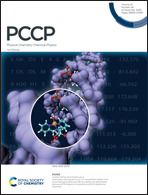Experimental study of the proton-transfer reaction C + H2+ → CH+ + H and its isotopic variant (D2+)
Abstract
We report absolute integral cross section (ICS) measurements using a dual-source merged-fast-beams apparatus to study the titular reactions over the relative translational energy range of Er ∼ 0.01–10 eV. We used photodetachment of C− to produce a pure beam of atomic C in the ground electronic 3P term, with statistically populated fine-structure levels. The H2+ and D2+ were formed in an electron impact ionization source, with well known vibrational and rotational distributions. The experimental work is complemented by a theoretical study of the CH2+ electronic system in the reactant and product channels, which helps to clarify the possible reaction mechanisms underlying the ICS measurements. Our measurements provide evidence that the reactions are barrierless and exoergic. They also indicate the apparent absence of an intermolecular isotope effect, to within the total experimental uncertainties. Capture models, taking into account either the charge-induced dipole interaction potential or the combined charge-quadrupole and charge-induced dipole interaction potentials, produce reaction cross sections that lie a factor of ∼4 above the experimental results. Based on our theoretical study, we hypothesize that the reaction is most likely to proceed adiabatically through the 14A′ and 14A′′ states of CH2+via the reaction C(3P) + H2+(2Σ+g) → CH+(3Π) + H(2S). We also hypothesize that at low collision energies only H2+(v ≤ 2) and D2+(v ≤ 3) contribute to the titular reactions, due to the onset of dissociative charge transfer for higher vibrational v levels. Incorporating these assumptions into the capture models brings them into better agreement with the experimental results. Still, for energies ≲0.1 eV where capture models are most relevant, the modified charge-induced dipole model yields reaction cross sections with an incorrect energy dependence and lying ∼10% below the experimental results. The capture cross section obtained from the combined charge-quadrupole and charge-induced dipole model better matches the measured energy dependence but lies ∼30–50% above the experimental results. These findings provide important guidance for future quasiclassical trajectory and quantum mechanical treatments of this reaction.



 Please wait while we load your content...
Please wait while we load your content...
